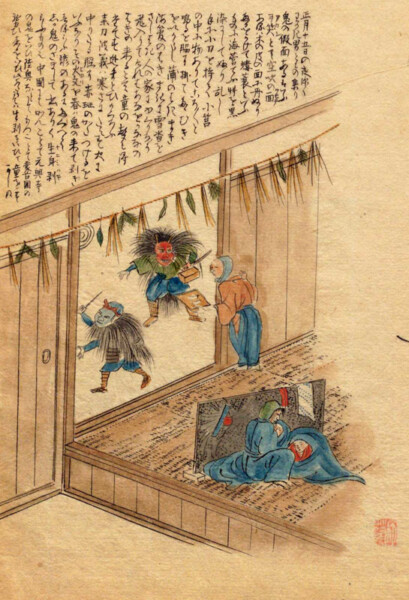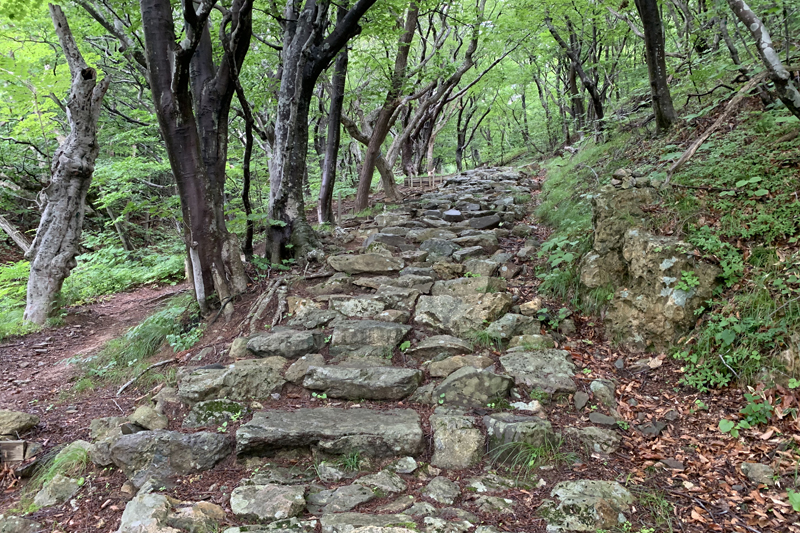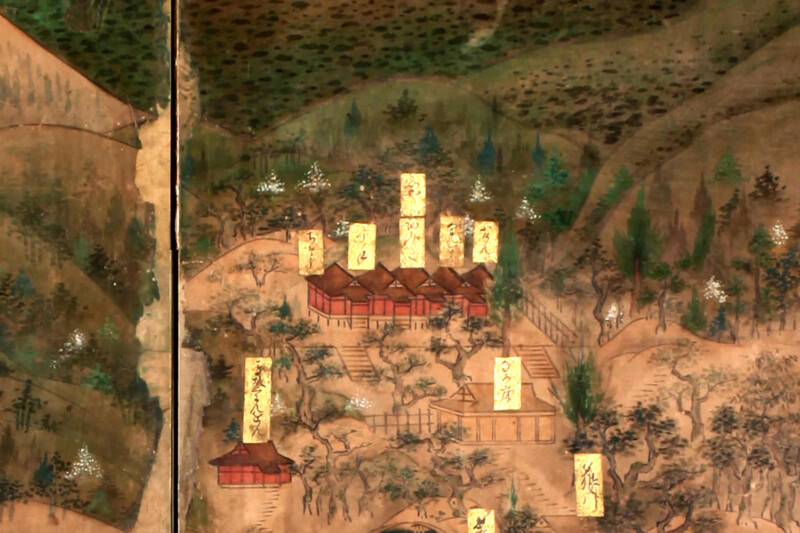
Why do Nama balds take knives to tempt people – Oga Peninsula and the Legend of the Demon (1) [Akita Prefecture]
table of contents
- 1 Namahage is a god who prays for villagers not to be lazy during the winter, and for good health and a good harvest in the new year.
- 2 There are various theories about the origin of Namahage. <The theory of Emperor Wu of Han> is one of them.
- 3 Namahage drawn by Masumi Sugae, a traveler from the Edo period
- 4 "Namahage Seibato Festival" held in heavy snow
- 5 A folk tale passed down in Oga: the legend of ``999 stone steps''
- 6 Akagami Shrine Goshado, a nationally important cultural property where the legend of 999 stone steps remains
- 7 Oga Peninsula and the Legend of the Demon
the word Oga, the first thing that comes to mind Namahage . Every year on New Year's Eve, demon-like people wearing masks with scary faces and costumes made of straw visit people's homes shouting, No lazy people, no crying children! In his hands, he holds a deba knife and a bucket.
Namahage is a god who prays for villagers not to be lazy during the winter, and for good health and a good harvest in the new year.

Namahage may seem scary at first glance, but it is actually said to be a god who scolds lazy people who spend all their time at the kotatsu and hearth during the winter agricultural off-season, and prays for good health and a rich harvest. `` is said to be ``Namomihagi,'' which means peeling off the flesh When you look at the literal meaning of ``flesh peeling'', you might imagine that it means ``flipping off the flesh!'' However, it is said that it involves peeling off the brown bruises caused by low-temperature burns caused by excessive exposure to fire .
The commonly known Namahage mask has a demon-like appearance and shape. Because he makes a loud noise and carries a knife in his hand, he can be scary for children, but for the local community, he is a visiting god who gives warnings and blessings. At the houses visited by Namahage, they are courteously entertained by preparing food and alcohol.
So what happened to Namahage?
There are various theories about the origin of Namahage. <The theory of Emperor Wu of Han> is one of them.

Emperor Wu, the seventh emperor of China's ancient Han dynasty (around the end of the Yayoi period in Japan), crossed the Sea of Japan and came to Oga with five bats in search of a medicinal herb for eternal youth and longevity. Bats transformed into demons and served Emperor Wu, and this demon is said to be the origin of the Namahage.
about the origin of the Namahage, including the theory that they were a Shugensha who practiced ascetic practices in the mountains of Oga they were a mountain god who had lived there since ancient times , but none of them have been confirmed. There is no.
Namahage drawn by Masumi Sugae, a traveler from the Edo period

Namahage is a traditional event that has been held in various villages in the Oga region for a long time, but it is not known when it began. The earliest record of Namahage seems to be in the Edo period, on January 15, 1811, when the traveler Masumi Sugae, who was traveling to Oga, wrote about it with illustrations.
The text attached to the illustration describes the Namahage event at the time. Young people wearing masks with devil-like expressions and hyottoko-like masks with pursed lips on the night of the 15th of the New Year (currently New Year's Eve, but at the time it was a small New Year event held on January 15). , visit the houses in the village. The children hide, saying that a Namahage has come. It's the same as now. It is not known whether he was yelling, "Is there a crying child?"

The Namahage Museum on the grounds of Mayama Shrine displays more than 150 types of Namahage masks from around 60 districts, including those actually used in the Namahage event on New Year's Eve, and you will be amazed at the richness of their expressions. Masu.

The corner where you can transform yourself into a Namahage and take a photo is popular.

"Namahage Seibato Festival" held in heavy snow

Oga Shinzan Denshokan which is adjacent to the Namahagekan , you can experience reenactments of Namahage events throughout the year. In addition, on the second Friday, Saturday, and Sunday of February every year, the Namahage Sedo , a tourist event that combines Shinto ritual Sedo Festival , is held will be done.
As the snow piles up, the solemn ritual that has been passed down at Mayama Shrine under the chai lanterns lit on the grounds of the shrine is very magical. In contrast, the wild movements of the Namahage are very impressive. The brave drums reverberate throughout your body.

`` Oga's Namahage '' is a nationally designated Important Intangible Folk Cultural Property, and is also listed on the UNESCO Intangible Cultural Heritage List as one of the Visiting Gods: Gods in Masks and Costumes
Information
- Facility name: Shinzan Shrine / Oga Shinzan Tradition Museum / Namahagekan
- Address: 97 Mizukaizawa, Mayama Kitaura, Oga City, Akita Prefecture
- Phone number: 0185-22-5050
- URL: Oga Shinzan Tradition Museum
- access:
- Public transportation: Approximately 40 minutes by Oga Peninsula Ainori taxi “Namahage Shuttle” from Oga Station on the JR Oga Line
- Car: Approximately 40 minutes from Akita Expressway Showa Oga Peninsula IC
- Facility name: “Oga Shinzan Folklore Museum”」
- Admission fee: General 770 yen, Elementary, junior high and high school students 550 yen, 2 museum ticket / General 1100 yen, Elementary and junior high school students 660 yen
- Namahage custom learning course (Namahage experience):
- April - November / 9:00 - 16:30 (Time required: approximately 20 minutes)
- December to March/9:30 to 15:30 (9:00 to 15:00 from January 1st to 2nd)
- Closed days: Open every day
- Facility name: “Namahagekan”
- Admission fee: General 660 yen, Elementary, junior high and high school students 330 yen, Combined ticket for 2 museums / General 1100 yen, Elementary, junior high and high school students 660 yen
- Opening hours: 8:30-17:00
- Closed days: Open every day
- Event name: “Namahage Saiba Lantern Festival”
- Date: 2nd Friday, Saturday, and Sunday of February
- Venue: Mayama Shrine precincts
Google Map
A folk tale passed down in Oga: the legend of ``999 stone steps''

It is said that the five demons who served Emperor Wu had one day off on the 15th of the New Year. On that day, they went to the village, plundered crops and livestock, and committed violent acts against village girls.
The troubled villagers come up with a plan. `` By the time the first rooster crows, build 1,000 stone steps from the village to the middle of the main mountain. If you can, I'll give you one daughter each year. If you can't do that, don't come down to the village again. '' I made a bet. The demons thought it was a simple task and happily piled up the stones. By morning, they had reached 999 steps, and the villager had asked for an Amanojaku who was good at making chicken crows and imitated the sound of a chicken. The demons mistakenly thought that morning had come and thought they had lost the bet, so they never came down to the village again.
Realizing that the demons had been tricked and fearing that they would take revenge, the villagers began to worship the demons as gods, and some say that this was the origin of Namahage.
Akagami Shrine Goshado, a nationally important cultural property where the legend of 999 stone steps remains

are located in a village called Monzen on the southern coastline of the Oga Peninsula It can also be climbed from the foot of the main mountain, near the worship hall of Akagami Shrine along Oga Shiokaze Kaido (Prefectural Route 59)
When you reach the top of the stone steps, you will see Goshado, which is home to five shrines . The current building was built in 1709 during the Edo period by Yoshitaka Satake, the lord of the Kubota domain, and has been designated as a national important cultural property as an extremely valuable Edo period temple and shrine building.
The five shrines of "Goshado" are from left to right: [ Juzenshido ] Hachiojido ] [ Akagami Gongendo ] Maroudo Gongendo] [ Sannomiyado ]. It is said that five demons (a married couple and three children) are enshrined in the five shrines. In addition, the zushi (box for storing important things such as Buddhist statues and memorial tablets) inside the [Akajin Gongen-do] hall is said to have been created during the Muromachi period and is a nationally important cultural property.


Akagami Shrine is a shrine located halfway up the main mountain (180m above sea level) of Mt. Shinzan (567m), Mt. Honzan (715m), and Mt. Kenashiyama It is said that it was founded in 860 during the Heian period Nishakuji During the Heian period, Shugendo, or Shugendo, was practiced in the mountains of Oga for ascetic practices, and Nishikaji Temple was the central temple. From the Heian period to the Edo period, there was a period of syncretization of Shintoism and Buddhism, where the gods of the shrines were enshrined inside temples.In the Meiji period, it was prohibited for temples and shrines to coexist (the policy of separating Shintoism and Buddhism). ), Nisseki-ji Temple was abandoned, and after that it came to be called Akagami Shrine. However, the main shrine is the ``Goshado'' that was built during the temple period, and although it is called a shrine, there is a temple hall and a Buddha statue enshrined there.
a wooden statue of Kannon Bodhisattva (Mokuzo Shokan Onbosatsuryuzo, a cultural property designated by Akita Prefecture), which is thought to have been made in the Heian period, a wooden statue standing statues of Eleven-faced Kannon Bodhisattva (Mokuzo Ichimenkan Nonbosatsu Ryuzo, designated cultural properties of Akita Prefecture) are enshrined here.
During the peak of Shugendo, thanks in part to the patronage of the Kubota clan, it is said that the main temple had nine temples, centered around Nissakuji, and 48 lodgings for Shugendo. However, due to the separation of Shinto and Buddhism and the policy of abolishing Buddhism after the Meiji Restoration, most of the temples were abandoned, and the only one that remained was Goshado, Akagami Shrine, which had changed its name from Nissekiji. and Chorakuji Temple only.
Information
- Facility name: Akagami Shrine Goshado, 999 stone steps
- Location: 35 Harakawa (Akagami Shrine), Funagawa Port Honzanmonzen, Oga City, Akita Prefecture
- Phone number: 0185-24-9220 (Oga City Tourism, Culture and Sports Department, Tourism Division)
- URL: Akagami Shrine Goshado, 999 stone steps
- access:
- Public transportation: From Oga Station on the JR Oga Line, take the Oga City Bus Oga Minami Line and get off at Monzen Parking Lot bus stop.
- Car: Approximately 40 minutes from Akita Expressway Showa Oga Peninsula IC







![Is Nama bald real? Traces of demons remaining throughout the Oga Peninsula - Oga Peninsula and the Legend of Demons (2) [Akita Prefecture] 1. Namahage Shiba Lighting Festival](https://jp.neft.asia/wp-content/uploads/2024/09/1076350e647a6476081bad8cd4fd6159-150x150.jpg)

![[First] Sugae Masumi walked in Oga Peninsula - Sankaze Mountain and the Head Mountains of Faith [Akita Prefecture] 1. Group of strange rocks_Akikaze_Archives](https://jp.neft.asia/wp-content/uploads/2024/10/af533a619304de93bb8c3974f774074e-150x150.jpg)
![Hot springs gush out in a place where there are no volcanoes! "Yuzawa Geopark" where you can see the mystery of the earth up close [Akita Prefecture] 4550228_m](https://jp.neft.asia/wp-content/uploads/2023/02/4550228_m-150x150.jpg)
![The popular game "Matagi" started in Kitaakita City! [Akita Prefecture] matagi](https://jp.neft.asia/wp-content/uploads/2024/04/matagi-150x150.jpg)
![Yurihonjo City, where Honjo, Kameda and Yajima domains were intersected between the Kubota and Shonai domains [Akita Prefecture] FF2C8AAA4350E7E179F97F97B38B3A2302F-1](https://jp.neft.asia/wp-content/uploads/2024/04/ff2c8aaa4350e7e179f97f38b3a2302f-1-150x150.jpg)
![Akita Cedar, which has been close to people's lives since ancient times, is a close look at the reasons and secrets [Akita Prefecture] Ninfu Mizusawa Cedar Rare Population Protection Forest (Noshiro City, Akita Prefecture)_Travel Tohoku](https://jp.neft.asia/wp-content/uploads/2025/05/792bcbe7d9fd514753f4deeaca3de33f-150x150.jpg)
![The submerged forests of Lake Akiogi can only be seen from May to June! A mysterious sight with trees floating in the lake [Akita Prefecture] Submerged forest of Lake Akifan](https://jp.neft.asia/wp-content/uploads/2023/07/IMG_5033-150x150.jpg)











